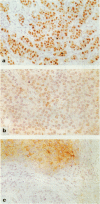Abstract
Little is known regarding the activity and function of the androgen receptor (AR) in human breast cancer. In the present study AR was evaluated in untreated primary breast cancers using antisera to the amino- and carboxy-termini of the receptor and quantitated using colour video image analysis. A strong correlation between tissue concentration and percentage AR-positive cells was observed for each antiserum. However, comparison of percentage positive cells using the amino- and carboxy-terminal AR antisera in individual breast cancer specimens revealed a subset of tumours with discordantly increased staining for the carboxy terminus. These findings suggest the presence of amino-terminal-truncated AR in a proportion of breast cancer cells or presence of AR mutations or associated protein alterations that affect binding of the amino-terminal AR antiserum. Immunohistochemical expression of the androgen-regulated glycoprotein, apolipoprotein D (apo-D), was also evaluated in the breast cancer specimens. Focal positivity of apo-D staining, which did not always co-localise with AR-positive cells, was observed within breast tumours. Furthermore, no correlation was evident between percentage positive cells stained for AR and apo-D in breast cancer specimens. These findings indicate that, although apo-D expression is androgen regulated in human breast cancer cell lines in vitro, its expression in primary breast cancers may be regulated by other factors. The expression of AR in primary breast cancers also suggests that the receptor may be involved in tumour responsiveness or in abnormal responses to endocrine therapies.
Full text
PDF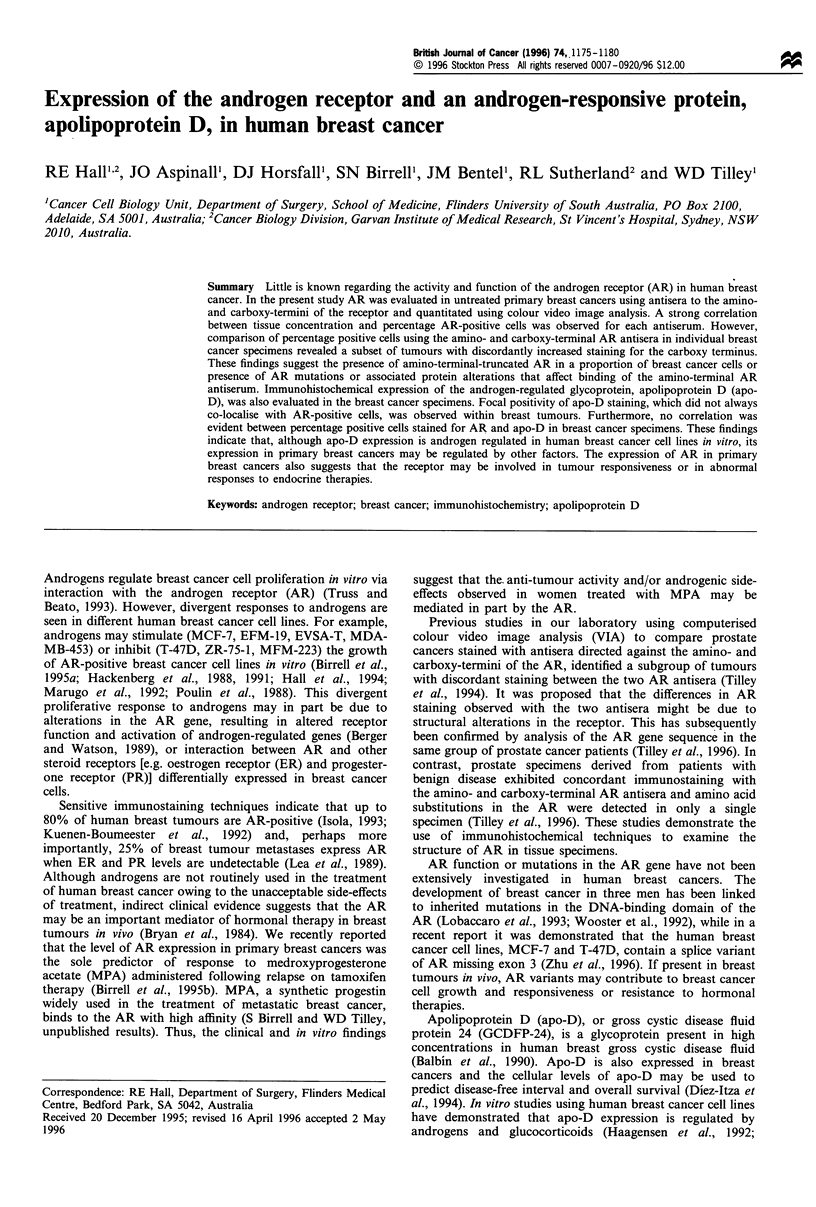
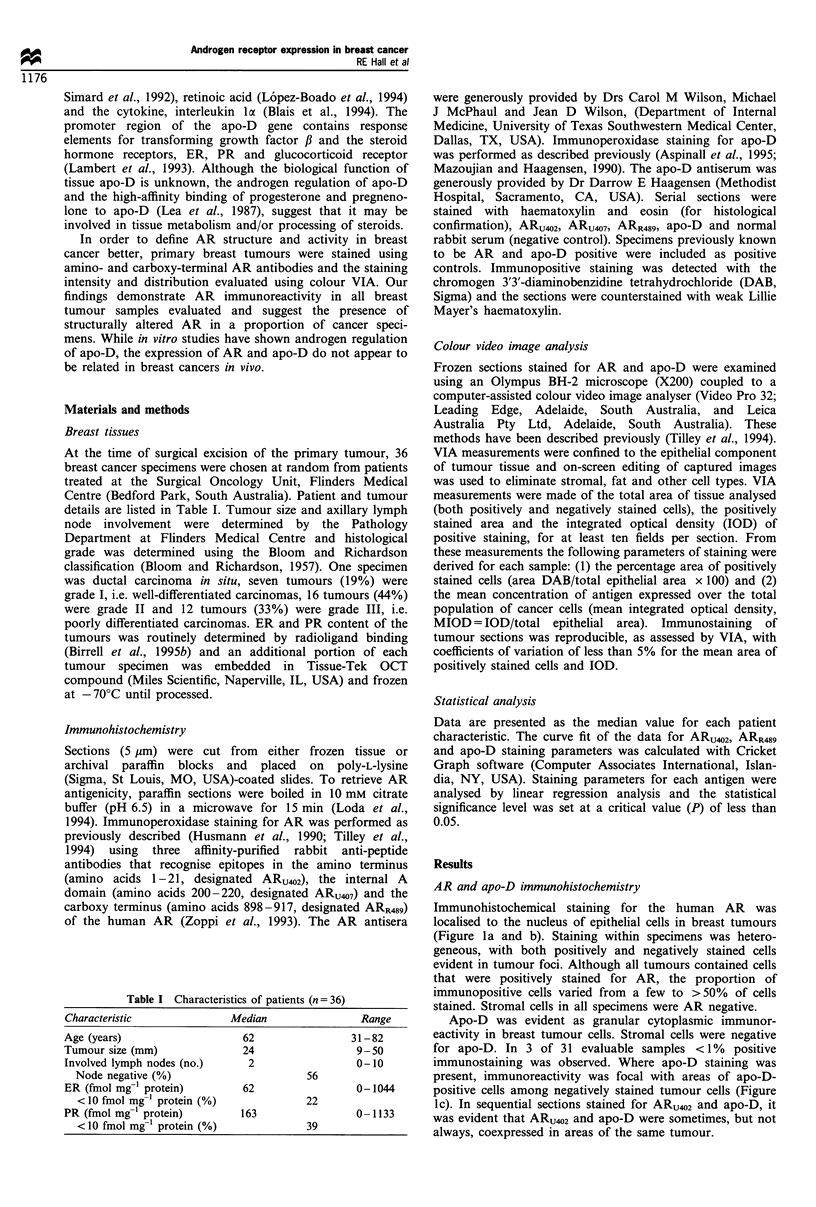
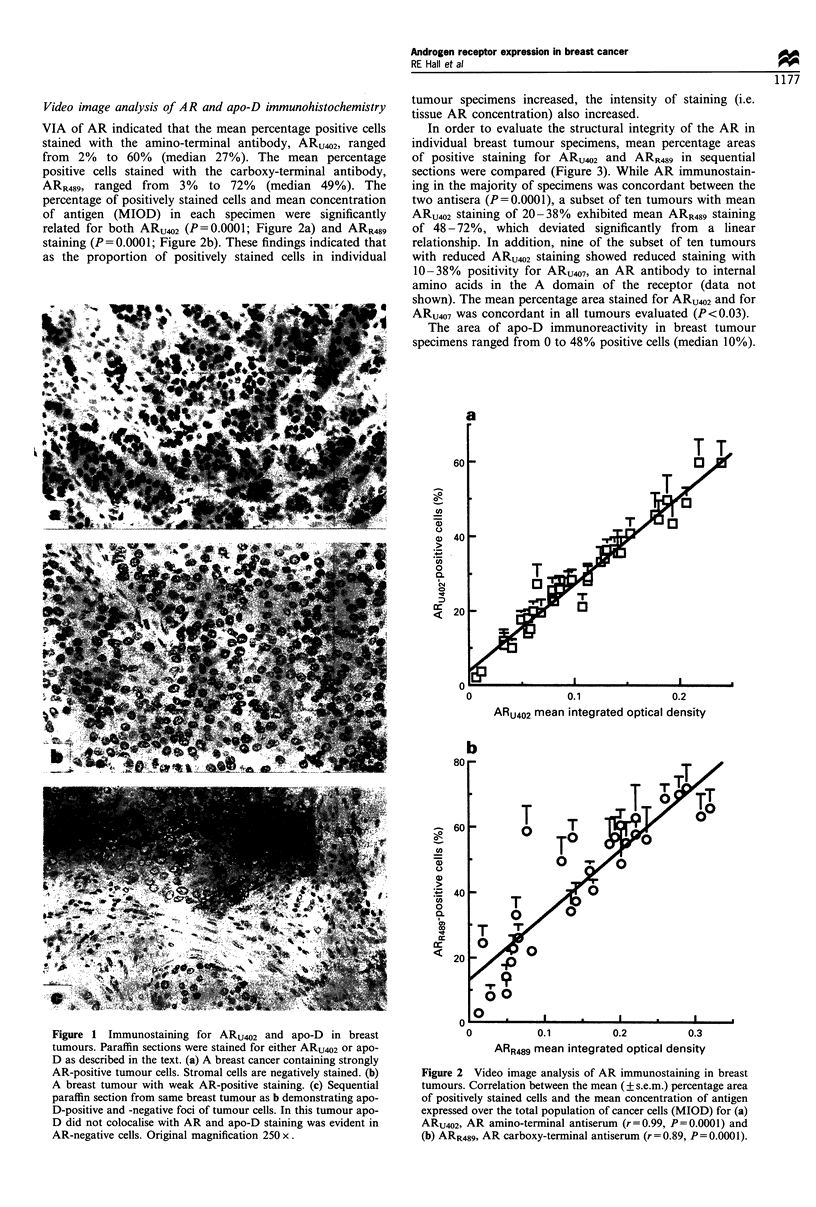
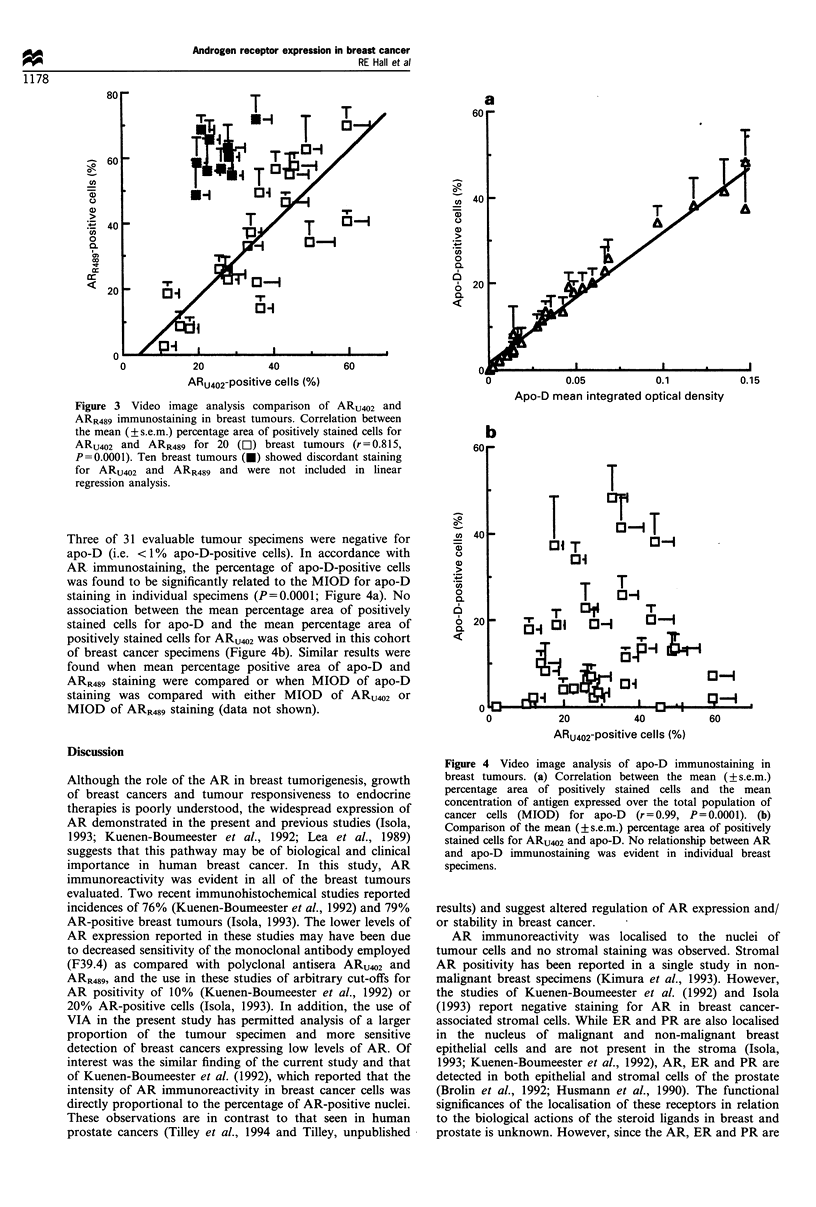
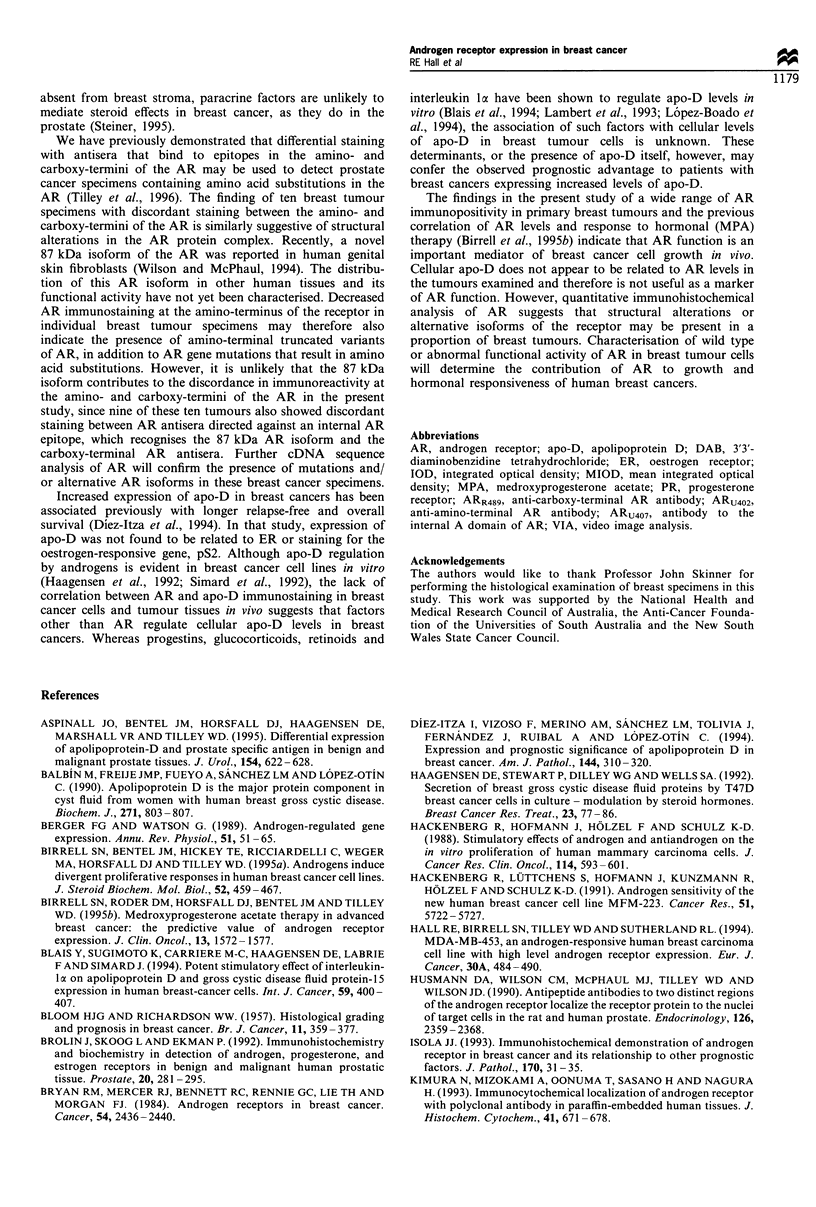
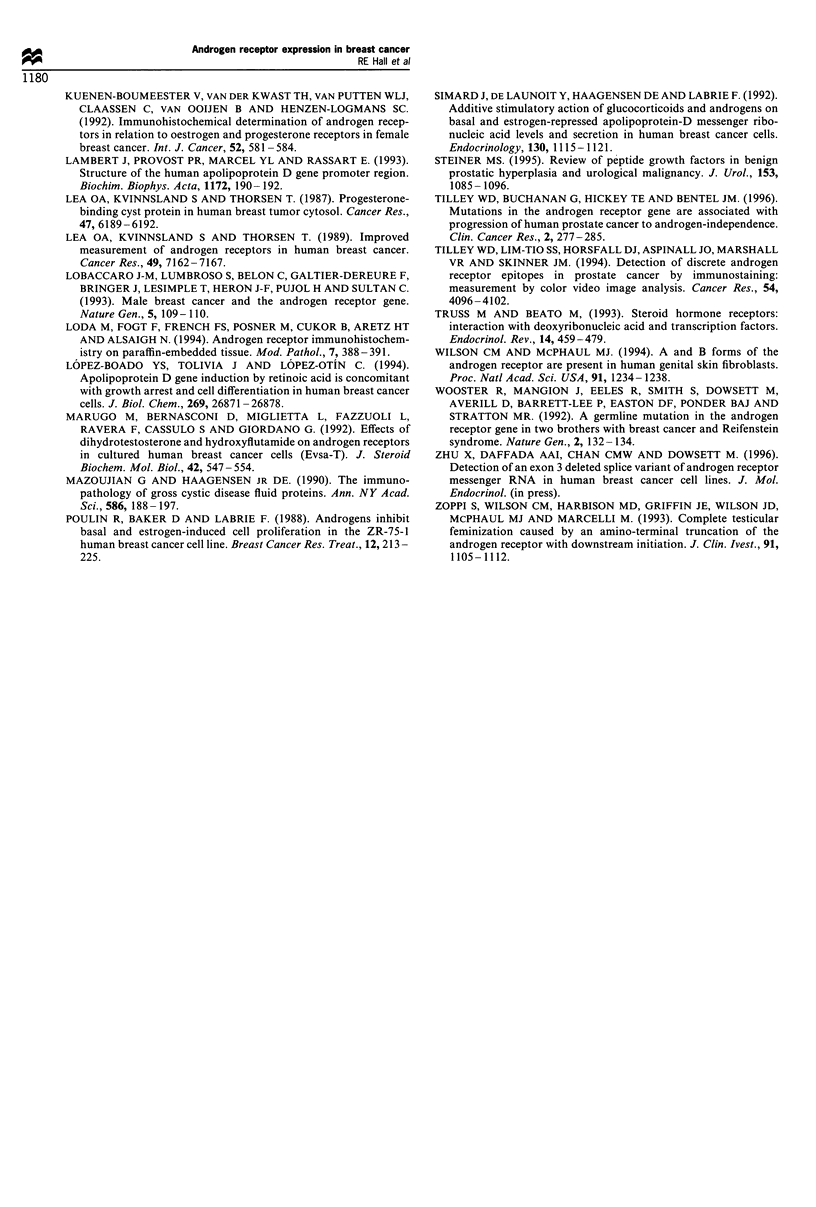
Images in this article
Selected References
These references are in PubMed. This may not be the complete list of references from this article.
- Aspinall J. O., Bentel J. M., Horsfall D. J., Haagensen D. E., Marshall V. R., Tilley W. D. Differential expression of apolipoprotein-D and prostate specific antigen in benign and malignant prostate tissues. J Urol. 1995 Aug;154(2 Pt 1):622–628. doi: 10.1097/00005392-199508000-00082. [DOI] [PubMed] [Google Scholar]
- BLOOM H. J., RICHARDSON W. W. Histological grading and prognosis in breast cancer; a study of 1409 cases of which 359 have been followed for 15 years. Br J Cancer. 1957 Sep;11(3):359–377. doi: 10.1038/bjc.1957.43. [DOI] [PMC free article] [PubMed] [Google Scholar]
- Balbín M., Freije J. M., Fueyo A., Sánchez L. M., López-Otín C. Apolipoprotein D is the major protein component in cyst fluid from women with human breast gross cystic disease. Biochem J. 1990 Nov 1;271(3):803–807. doi: 10.1042/bj2710803. [DOI] [PMC free article] [PubMed] [Google Scholar]
- Berger F. G., Watson G. Androgen-regulated gene expression. Annu Rev Physiol. 1989;51:51–65. doi: 10.1146/annurev.ph.51.030189.000411. [DOI] [PubMed] [Google Scholar]
- Birrell S. N., Bentel J. M., Hickey T. E., Ricciardelli C., Weger M. A., Horsfall D. J., Tilley W. D. Androgens induce divergent proliferative responses in human breast cancer cell lines. J Steroid Biochem Mol Biol. 1995 May;52(5):459–467. doi: 10.1016/0960-0760(95)00005-k. [DOI] [PubMed] [Google Scholar]
- Birrell S. N., Roder D. M., Horsfall D. J., Bentel J. M., Tilley W. D. Medroxyprogesterone acetate therapy in advanced breast cancer: the predictive value of androgen receptor expression. J Clin Oncol. 1995 Jul;13(7):1572–1577. doi: 10.1200/JCO.1995.13.7.1572. [DOI] [PubMed] [Google Scholar]
- Blais Y., Sugimoto K., Carriere M. C., Haagensen D. E., Labrie F., Simard J. Potent stimulatory effect of interleukin-1 alpha on apolipoprotein D and gross cystic disease fluid protein-15 expression in human breast-cancer cells. Int J Cancer. 1994 Nov 1;59(3):400–407. doi: 10.1002/ijc.2910590319. [DOI] [PubMed] [Google Scholar]
- Brolin J., Skoog L., Ekman P. Immunohistochemistry and biochemistry in detection of androgen, progesterone, and estrogen receptors in benign and malignant human prostatic tissue. Prostate. 1992;20(4):281–295. doi: 10.1002/pros.2990200404. [DOI] [PubMed] [Google Scholar]
- Bryan R. M., Mercer R. J., Bennett R. C., Rennie G. C., Lie T. H., Morgan F. J. Androgen receptors in breast cancer. Cancer. 1984 Dec 1;54(11):2436–2440. doi: 10.1002/1097-0142(19841201)54:11<2436::aid-cncr2820541121>3.0.co;2-h. [DOI] [PubMed] [Google Scholar]
- Díez-Itza I., Vizoso F., Merino A. M., Sánchez L. M., Tolivia J., Fernández J., Ruibal A., López-Otín C. Expression and prognostic significance of apolipoprotein D in breast cancer. Am J Pathol. 1994 Feb;144(2):310–320. [PMC free article] [PubMed] [Google Scholar]
- Haagensen D. E., Stewart P., Dilley W. G., Wells S. A. Secretion of breast gross cystic disease fluid proteins by T47D breast cancer cells in culture--modulation by steroid hormones. Breast Cancer Res Treat. 1992;23(1-2):77–86. doi: 10.1007/BF01831479. [DOI] [PubMed] [Google Scholar]
- Hackenberg R., Hofmann J., Hölzel F., Schulz K. D. Stimulatory effects of androgen and antiandrogen on the in vitro proliferation of human mammary carcinoma cells. J Cancer Res Clin Oncol. 1988;114(6):593–601. doi: 10.1007/BF00398183. [DOI] [PubMed] [Google Scholar]
- Hackenberg R., Lüttchens S., Hofmann J., Kunzmann R., Hölzel F., Schulz K. D. Androgen sensitivity of the new human breast cancer cell line MFM-223. Cancer Res. 1991 Oct 15;51(20):5722–5727. [PubMed] [Google Scholar]
- Hall R. E., Birrell S. N., Tilley W. D., Sutherland R. L. MDA-MB-453, an androgen-responsive human breast carcinoma cell line with high level androgen receptor expression. Eur J Cancer. 1994;30A(4):484–490. doi: 10.1016/0959-8049(94)90424-3. [DOI] [PubMed] [Google Scholar]
- Husmann D. A., Wilson C. M., McPhaul M. J., Tilley W. D., Wilson J. D. Antipeptide antibodies to two distinct regions of the androgen receptor localize the receptor protein to the nuclei of target cells in the rat and human prostate. Endocrinology. 1990 May;126(5):2359–2368. doi: 10.1210/endo-126-5-2359. [DOI] [PubMed] [Google Scholar]
- Isola J. J. Immunohistochemical demonstration of androgen receptor in breast cancer and its relationship to other prognostic factors. J Pathol. 1993 May;170(1):31–35. doi: 10.1002/path.1711700106. [DOI] [PubMed] [Google Scholar]
- Kimura N., Mizokami A., Oonuma T., Sasano H., Nagura H. Immunocytochemical localization of androgen receptor with polyclonal antibody in paraffin-embedded human tissues. J Histochem Cytochem. 1993 May;41(5):671–678. doi: 10.1177/41.5.8468448. [DOI] [PubMed] [Google Scholar]
- Kuenen-Boumeester V., Van der Kwast T. H., van Putten W. L., Claassen C., van Ooijen B., Henzen-Logmans S. C. Immunohistochemical determination of androgen receptors in relation to oestrogen and progesterone receptors in female breast cancer. Int J Cancer. 1992 Oct 21;52(4):581–584. doi: 10.1002/ijc.2910520415. [DOI] [PubMed] [Google Scholar]
- Lambert J., Provost P. R., Marcel Y. L., Rassart E. Structure of the human apolipoprotein D gene promoter region. Biochim Biophys Acta. 1993 Feb 20;1172(1-2):190–192. doi: 10.1016/0167-4781(93)90292-l. [DOI] [PubMed] [Google Scholar]
- Lea O. A., Kvinnsland S., Thorsen T. Improved measurement of androgen receptors in human breast cancer. Cancer Res. 1989 Dec 15;49(24 Pt 1):7162–7167. [PubMed] [Google Scholar]
- Lea O. A., Kvinnsland S., Thorsen T. Progesterone-binding cyst protein in human breast tumor cytosol. Cancer Res. 1987 Dec 1;47(23):6189–6192. [PubMed] [Google Scholar]
- Lobaccaro J. M., Lumbroso S., Belon C., Galtier-Dereure F., Bringer J., Lesimple T., Heron J. F., Pujol H., Sultan C. Male breast cancer and the androgen receptor gene. Nat Genet. 1993 Oct;5(2):109–110. doi: 10.1038/ng1093-109. [DOI] [PubMed] [Google Scholar]
- Loda M., Fogt F., French F. S., Posner M., Cukor B., Aretz H. T., Alsaigh N. Androgen receptor immunohistochemistry on paraffin-embedded tissue. Mod Pathol. 1994 Apr;7(3):388–391. [PubMed] [Google Scholar]
- López-Boado Y. S., Tolivia J., López-Otín C. Apolipoprotein D gene induction by retinoic acid is concomitant with growth arrest and cell differentiation in human breast cancer cells. J Biol Chem. 1994 Oct 28;269(43):26871–26878. [PubMed] [Google Scholar]
- Marugo M., Bernasconi D., Miglietta L., Fazzuoli L., Ravera F., Cassulo S., Giordano G. Effects of dihydrotestosterone and hydroxyflutamide on androgen receptors in cultured human breast cancer cells (EVSA-T). J Steroid Biochem Mol Biol. 1992 Jun;42(5):547–554. doi: 10.1016/0960-0760(92)90268-n. [DOI] [PubMed] [Google Scholar]
- Mazoujian G., Haagensen D. E., Jr The immunopathology of gross cystic disease fluid proteins. Ann N Y Acad Sci. 1990;586:188–197. doi: 10.1111/j.1749-6632.1990.tb17806.x. [DOI] [PubMed] [Google Scholar]
- Simard J., de Launoit Y., Haagensen D. E., Labrie F. Additive stimulatory action of glucocorticoids and androgens on basal and estrogen-repressed apolipoprotein-D messenger ribonucleic acid levels and secretion in human breast cancer cells. Endocrinology. 1992 Mar;130(3):1115–1121. doi: 10.1210/endo.130.3.1537279. [DOI] [PubMed] [Google Scholar]
- Steiner M. S. Review of peptide growth factors in benign prostatic hyperplasia and urological malignancy. J Urol. 1995 Apr;153(4):1085–1096. [PubMed] [Google Scholar]
- Tilley W. D., Buchanan G., Hickey T. E., Bentel J. M. Mutations in the androgen receptor gene are associated with progression of human prostate cancer to androgen independence. Clin Cancer Res. 1996 Feb;2(2):277–285. [PubMed] [Google Scholar]
- Tilley W. D., Lim-Tio S. S., Horsfall D. J., Aspinall J. O., Marshall V. R., Skinner J. M. Detection of discrete androgen receptor epitopes in prostate cancer by immunostaining: measurement by color video image analysis. Cancer Res. 1994 Aug 1;54(15):4096–4102. [PubMed] [Google Scholar]
- Truss M., Beato M. Steroid hormone receptors: interaction with deoxyribonucleic acid and transcription factors. Endocr Rev. 1993 Aug;14(4):459–479. doi: 10.1210/edrv-14-4-459. [DOI] [PubMed] [Google Scholar]
- Wilson C. M., McPhaul M. J. A and B forms of the androgen receptor are present in human genital skin fibroblasts. Proc Natl Acad Sci U S A. 1994 Feb 15;91(4):1234–1238. doi: 10.1073/pnas.91.4.1234. [DOI] [PMC free article] [PubMed] [Google Scholar]
- Wooster R., Mangion J., Eeles R., Smith S., Dowsett M., Averill D., Barrett-Lee P., Easton D. F., Ponder B. A., Stratton M. R. A germline mutation in the androgen receptor gene in two brothers with breast cancer and Reifenstein syndrome. Nat Genet. 1992 Oct;2(2):132–134. doi: 10.1038/ng1092-132. [DOI] [PubMed] [Google Scholar]
- Zoppi S., Wilson C. M., Harbison M. D., Griffin J. E., Wilson J. D., McPhaul M. J., Marcelli M. Complete testicular feminization caused by an amino-terminal truncation of the androgen receptor with downstream initiation. J Clin Invest. 1993 Mar;91(3):1105–1112. doi: 10.1172/JCI116269. [DOI] [PMC free article] [PubMed] [Google Scholar]



